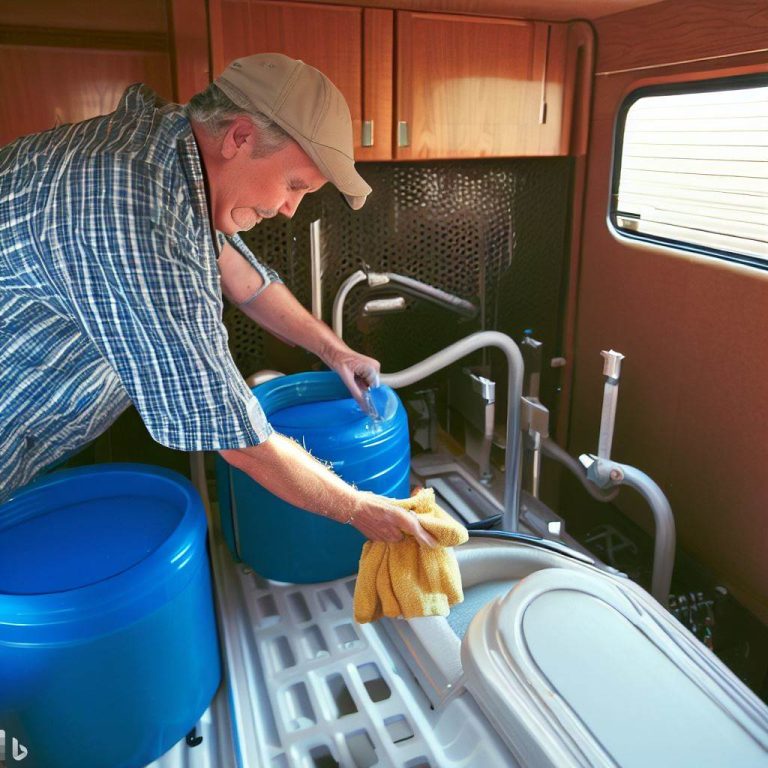
Understanding RV Holding Tanks: Cleaning and Maintenance
RVs provide the freedom to travel and explore the great outdoors while enjoying the comforts of home. However, with that convenience comes the responsibility of maintaining various systems, including the all-important holding tanks. These tanks store your RV’s waste and water, and proper cleaning and maintenance are essential to ensure a trouble-free journey. In this article, we’ll dive into the world of RV holding tanks, discussing their types, cleaning methods, and maintenance tips.
Types of RV Holding Tanks
RVs typically have three main types of holding tanks: fresh water tanks, gray water tanks, and black water tanks.
- Fresh Water Tanks: These tanks store the clean, potable water used for drinking, cooking, and showering. Keeping the fresh water tank clean is vital to maintaining the quality of your water supply.
- Gray Water Tanks: Gray water tanks collect water from sinks and showers. This water is relatively cleaner than black water but may still contain soap residue, food particles, and grease.
- Black Water Tanks: The black water tank holds human waste and toilet paper. Treating and maintaining the black water tank is crucial for preventing odors and ensuring proper sanitation.
Cleaning Your RV Holding Tanks
Proper cleaning of your RV holding tanks is essential for hygiene, odor control, and preventing clogs. Here’s a step-by-step guide to effectively clean your tanks:
- Gather Supplies:
- Rubber gloves
- Tank cleaning wand or hose attachment
- Tank cleaning solution (commercial or homemade)
- Baking soda
- Vinegar
- Bucket
- Empty the Tanks:
Before cleaning, ensure that your RV is parked in a designated dumping station. Empty the black water tank first, followed by the gray water tank, and finally the fresh water tank. - Black Water Tank Cleaning:
- Close the black water tank valve and fill it with water using the hose attachment or a bucket.
- Add a tank cleaning solution according to the manufacturer’s instructions. Alternatively, mix baking soda and water to help break down waste and odors.
- Let the solution sit for a few hours or as directed.
- Open the valve and let the tank contents drain completely. Flush the tank with fresh water until it runs clear.
- Gray Water Tank Cleaning:
- Open the gray water tank valve and allow it to empty.
- Flush the tank with clean water, ensuring any residue is washed away.
- Fresh Water Tank Cleaning:
- Drain the fresh water tank completely.
- Mix a solution of water and vinegar (1:2 ratio) and pour it into the tank.
- Fill the tank with clean water and let the solution sit for a few hours.
- Drain the tank again and flush it with fresh water until the vinegar smell dissipates.
Regular Maintenance Tips
To keep your RV holding tanks in top condition, follow these maintenance tips:
- Use RV-Friendly Products:
Use only RV-approved toilet paper and cleaning products. Regular household products may damage tank sensors and disrupt tank bacteria. - Maintain Proper Tank Levels:
Avoid overfilling tanks, especially the black water tank. An overfilled tank can lead to leaks, odors, and potential damage. - Use Tank Treatments:
Use specialized tank treatments to maintain healthy bacteria levels in your tanks. These treatments help break down waste and control odors. - Keep Valves Lubricated:
Regularly lubricate the valves with a silicone-based lubricant to ensure they operate smoothly and prevent leaks. - Monitor Tank Sensors:
Calibrate and clean tank sensors regularly to ensure accurate readings. A malfunctioning sensor can lead to incorrect tank level readings. - Avoid Harsh Chemicals:
Avoid using harsh chemicals, bleach, or formaldehyde-based products in your tanks. These can harm the tank components and disrupt the natural bacterial balance. - Regular Inspections:
Periodically inspect tanks, hoses, and connections for leaks, cracks, or damage. Catching issues early prevents costly repairs.
In conclusion, understanding and maintaining your RV holding tanks are essential for a comfortable and hassle-free journey. Regular cleaning, proper usage of tank-friendly products, and consistent maintenance will help you enjoy your RV adventures while ensuring your tanks function optimally. By following these tips, you’ll have a well-maintained RV system that contributes to a memorable travel experience.